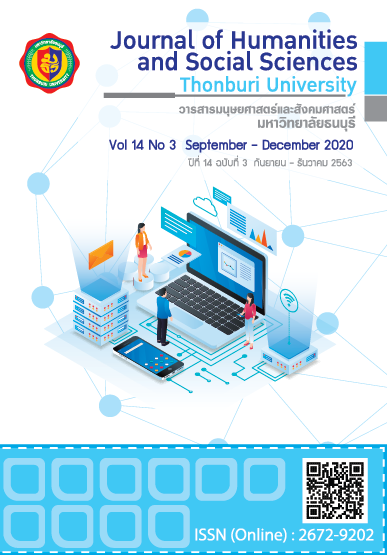The influence of sharing economy: Distributive justice, network relation, and self-employment on career commitment
Keywords:
Business management, Sharing economy, Commitment, Professional, Self-employmentAbstract
Abstract
The objective of this research was 1) to investigate the perception level of the sharing justice, network relation, and profession independence among Grab operators, 2) to investigate the perception level of the confidence, self-regulation, and professional engagement in the self-employment among Grab operators, and 3) to investigate the influence of Grab's administrative factors. According to the quantitative study, the profession independence was the highest influential factor of 0.656, followed by the network relation while the e perception of the sharing justice was the very low influential factor. According to the qualitative study through interviews, the interviewees wanted to develop technology for justice make Grab a legal career. Additional rules and regulations should be established to be in line with the form of calling passenger car services through the application so that unfair business practices can be controlled and minimized. Moreover, there should be cooperation between Grab and the government in supporting the start-up operators to generate their income in order to improve the quality of life of the people in Thailand.
Keywords: Business management, Sharing economy, Commitment, Professional, Self-employment
References
บริษัท แกร็บ (ประเทศไทย) จำกัด. (2562). แกร็บฟูด เปิดตัวสุดยอดแคมเปญแห่งปี ‘Grab Food 8.8 Mega Sale’ ผนึกกำลังพาร์ทเนอร์ร้านอาหารจัดเต็มส่วนลดกว่า 80% พร้อม 8,000 ดีล.กรุงเทพฯ. สืบค้นเมื่อ 10 ตุลาคม 2562, จาก https://www.grab.com/th/press/business/grabfood-8-8-mega-sale/
Allen, R. & van den Berg, T. (Eds.). (2014). Serialization in popular culture. New York: Routledge.
Belk, R. (2007). Why not share rather than own? .The Annals of the American Academy of Political and Social Science, 611(1): 126-140.
Bollen, K.A. (1990). "Overall Fit in Covariance Structure Models: Two Types of Sample Size Effects," Psychological Bulletin, 107 (2): 256-259.
Byrne, B.M. (1998). Structural Equation Modeling with LISREL, PRELIS and SIMPLIS: Basic Concepts, Applications and Programming. Mahwah, New Jersey: Lawrence Erlbaum Associates.
Cohen, J. and Uphoff, N. (1977). Rural Development Participation: Concepts and Measures for ProjectDesign, Implementation and Evaluation2nded.USA: Center for International Studies.
Colquitt, A., Conlon, E., Wesson, J. & Porter, O., L., H. (2001). Justice at the Millennium: A Meta-Analytic Review of 25 Years of Organizational Justice Research. Journal of Applied Psychology, 86(3):425-445.
Diamantopoulos, A. & Siguaw, J.A. (2000). Introducing LISREL. London: Sage Publications.
Evan, L., Wadey, R., Hanton, S. & Mitchell, I. (2012). Stressors experienced by injured athletes. Journal of Sports Sciences, 30 (9):917-927.
Hu, L.T. and Bentler, P.M. (1999). Cutoff Criteria for Fit Indexes in Covariance Structure Analysis: Conventional Criteria versus New Alternatives. Structural Equation Modeling, 6 (1): 1-55.
MacCallum, R.C., Browne, M.W., and Sugawara, H., M. (1996). "Power Analysis and Determination of Sample Size for Covariance Structure Modeling. Psychological Methods, 1 (2), 130-149.
Matzler, K., Veider, V., & Kathan, W. (2015). Adapting to the sharing economy. MIT Sloan Management Review, 56(2): 71-77.
Robbins, T., Judge, A. &Hasham, S. (2015). Organizational Behavior. England: Pearson Education Limited.
Schaufeli, Salanova, Gonzalez-Roma & Bakker. (2001). The Measurement of Engagement and Burnout:A Two Sample Confirmatory Factor Analytic Approach. Journal of Happiness Studies, 3: 71–92.
Schermelleh-Engel, K., Moosbrugger, H., and Müller, H. (2003). Evaluating the Fit of Structural Equation Models: Tests of Significance and Descriptive Goodness of-Fit Measures.Methods of Psychological Research Online, 8(2): 23-74.
Sharma, S., Mukherjee, S., Kumar, A., and Dillon, W.R. (2005), A simulation study to investigate the use of cutoff values for assessing model fit in covariance structure models. Journal of Business Research, 58 (1): 935-943.
Vandenberg, R. J. (2006). Statistical and Methodological Myths and Urban Legends. Organizational Research Methods, 9(2): 194-201.
Wesley G. Skogan (2005) Citizen Satisfaction with Police Encounters. Police Quarterly, 8 (3): 298–321.
Wheaton, B., Muthen, B., Alwin, D., F., and Summers, G. (1977). Assessing Reliability and Stability in Panel odels. Sociological Methodology, 8 (1): 84-136.
Yamane, Taro. (1967). Statistics an Introductory Analysis. 2nded. New York: Harper and Row.
Translated Thai References
Grab (Thailand) Ltd. (2019). Grab Food has launched the ultimate campaign of the year 'Grab Food 8.8 Mega Sale' by joining with restaurants to offer discounts of over 80% and 8,000 deals in Bangkok Retrieved October 10, 2019, from https://www.grab.com/th/press/business/grabfood-8-8-mega-sale/ (in Thai)







